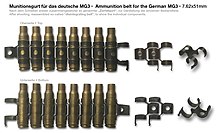Ammunition belt

The ammunition belt is a device for supplying ammunition , on which cartridges are lined up next to each other and supply a firearm , typically a machine gun . The belt holds the cartridges together so that they can be fired evenly. Belts are usually stored in so-called belt boxes for use. Belts have a higher capacity, usually 100–250 cartridges, than magazines .
history

One of the first machine guns with ammunition through belts was the Maxim machine gun . Its inventor, Hiram Maxim , created a weapon in 1885 with a fire density that had not been achieved before. Maxim sold licenses of its construction in many countries. This resulted in a series of machine guns to which the standard rifle cartridge of the respective country was supplied in belt form.
The long-life belts of the first MGs were mostly made of textile fabric, which tended to swell when wet and caused loading jams. During the First World War, metal link belts that were insensitive to moisture were introduced , initially in the on-board machine guns of fighter aircraft such as the Vickers machine gun .
Especially with older MGs, e.g. B. M1919 , M2 , Vickers and Maxim , the cartridge is pulled rearward from the belt and then into the underlying firing chamber out. Also the PK uses this mechanism due to the rimmed cartridge 7.62 × 54 mm R .
In most modern machine guns, the cartridge is pulled straight out of the ammunition belt through the lock and inserted into the chamber. This requires that the belt link not completely encircle the cartridge.
Types of ammunition belts
Permanent belts


Originally, permanent belts were used, which could be re-ammunitioned after use. The first textile belts were later replaced by metal permanent belts, which consist of light sheet metal parts for the cartridge and a wire spiral between the individual links as a hinge. These metal belts are - in addition to disintegration belts - in the Bundeswehr z. B. used for the MG3 .
Decay belts

In the course of time, so-called decay belts were developed, which are either cut by the machine gun after the shot has been fired or disintegrate when the cartridges are pushed into the chamber. The advantage over the permanent belt lies in the lower weight and the improved handling of the weapon, since the belt only hangs on the weapon on the feed side. Disintegration belts consist of metal links that are connected to one another or by the inserted cartridges and therefore do not fall apart when filled and ammunitioned. The belt of the Vickers on-board machine guns of the First World War was already a disintegration belt. A belt channel is sometimes used for the trouble-free feeding of the decay belt to the weapon.
Individual evidence
- ↑ Metal Belt Links For WW 1 US M1915 Vickers Aircraft Gun, Phosphate Finish. (No longer available online.) Archived from the original on January 31, 2015 ; Retrieved January 19, 2014 .


